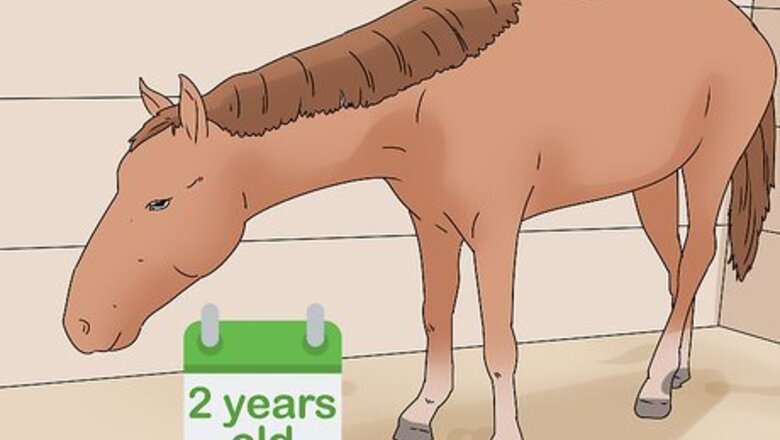
views
Preparing Your Horse through Basic Training

Make sure your horse is at least 2 years old. Young horses this age are physically mature and ready to learn. Low-impact work done in short intervals helps young horses develop their joints and muscles. If training begins too early, horses can face physical problems like joint pain and bone spurs. If your horse is younger than 2, it may be best to wait until it is older. Speak to a veterinarian or trainer for further advice. Though younger horses are easier to train, horses past 4 years of age can still be trained, as well as older horses past 10 years old.
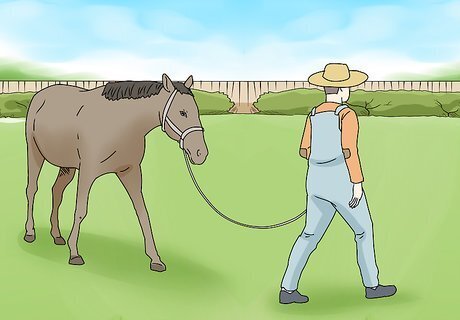
Teach your horse to listen with lead exercises. Lead your horse on a halter and rope. Walk in front of your horse with the rope, or walk near their shoulder in what’s called “the partner position.” Your horse will learn to respect your space and adjust its speed according to yours. Every horse learns at a different pace. Learning a new exercise can take weeks or months with almost daily training in 30-minute increments.

Practice exercises to make your horse comfortable with touch. Touch exercises help horses accept and trust being touched. Since horses wear riding equipment (tack) on their face and back, this is important. Touch your horse with your hands, cloth, or pieces of tack to get it accustomed to the feeling. Grooming can serve as a reward for your horse, or a way to bond with their owner or trainer. Gradually touching your horse with a saddle blanket and eventually laying the blanket on its back help them get used to the weight and feeling.

Train your horse to follow directions through circle work. Stand in the center of a circle. Using a lead rope connected to its halter, guide your horse around you using vocal commands. Your horse learns how to move towards the left, move towards the right, and transition from left to right. Circle work trains your horse in following commands, and will prepare it to listen to a rider’s commands.

Continue to train your horse until it's ready for saddle training. Your horse should be comfortable with a halter, reins, and lead ropes, which will help it get used to being saddled. It should also be comfortable being touched, and should know how to follow and listen to commands through lead exercises and circle work. Make sure your horse has good ground manners and interacts well with people before going further in training. Time spent training depends on the horse’s age and personality. It can take weeks or months to be prepared for starting under saddle.
Introducing Your Horse to a Saddle

Ask someone to help you introduce the saddle. Your horse should already be familiar with riding tack and a saddle pad before you put on the saddle, or else it could get stressed. Have someone your horse already knows gently hold it in place. Your horse will look to your helper for reassurance, so having someone calm nearby will help ease its mood. Don’t tie your horse while saddling, which can be dangerous if it gets spooked. Your helper should hold it in place.
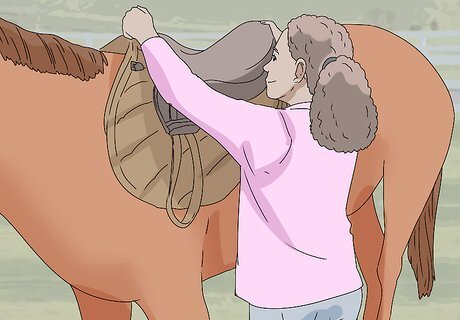
Place the saddle on your horse’s back. Since you traditionally mount your horse on its left side, approach it from that side. Rub it with the saddle pad before placing it on its back, remembering to give praise. Heft the saddle quickly and smoothly onto the pad, and let it sit there for 1-2 minutes. If your horse looks comfortable, cinch the girth (saddle strap) just snug enough to keep it in place.
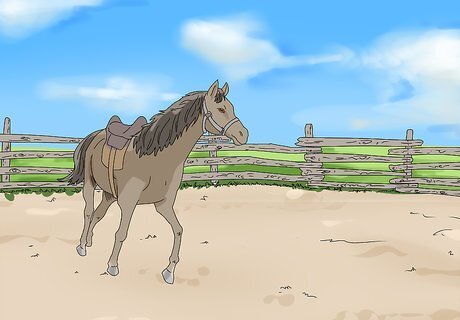
Tighten the girth in intervals. Give positive reinforcement when it accepts the girth. Allow your horse to walk and jog around on its own to get used to the saddle. Stay out of the way. It may take several days in a row for your horse to get comfortable wearing the saddle. Make sure your horse has accepted the saddle and is comfortable wearing it before you try mounting. You'll know your horse is comfortable when it doesn't try to remove the saddle with its mouth, flinch when being saddled, or seem skittish when wearing it.
Getting Your Horse Comfortable Wearing a Saddle
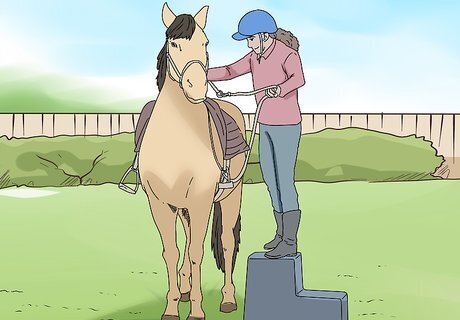
Use a mounting block to climb in the saddle. Guide your horse next to a mounting block. From the block, push down and lean into the saddle with your hands, allowing it to feel your weight. You may need to try this multiple times so the horse is used to having weight in the stirrups without moving away. Mount your horse and sit calmly in the saddle for a few minutes before dismounting. Knowing how to mount a horse properly will help you as a rider, and help your horse get used to the sensation.

Mount and dismount from the saddle in 10-minute intervals. Your horse will get used to the motion of being mounted and dismounted. It will also get comfortable holding the weight of a rider. Remain in the saddle in short periods of time and don't move. This will build their strength and prevent injury to joints or muscles.

Begin walking your horse while in the saddle. When you're in the saddle, gently squeeze your horse with your legs to begin walking. If it doesn't begin walking, you can gently tap it with your heels. Low-impact, low-speed exercise done in sessions of 30 minutes to 1 hour are best for your horse’s training and health. Your horse is ready for walking if it does not flinch or resist when being saddled or mounted.


















Comments
0 comment